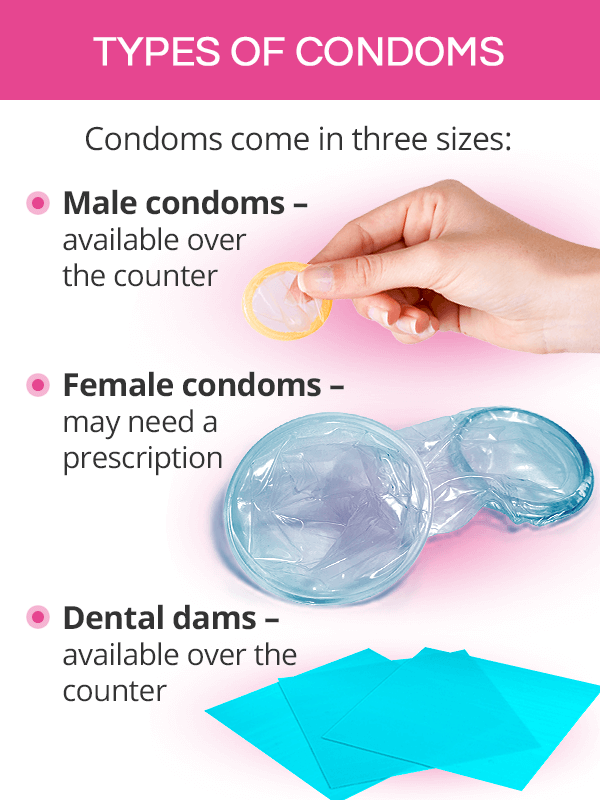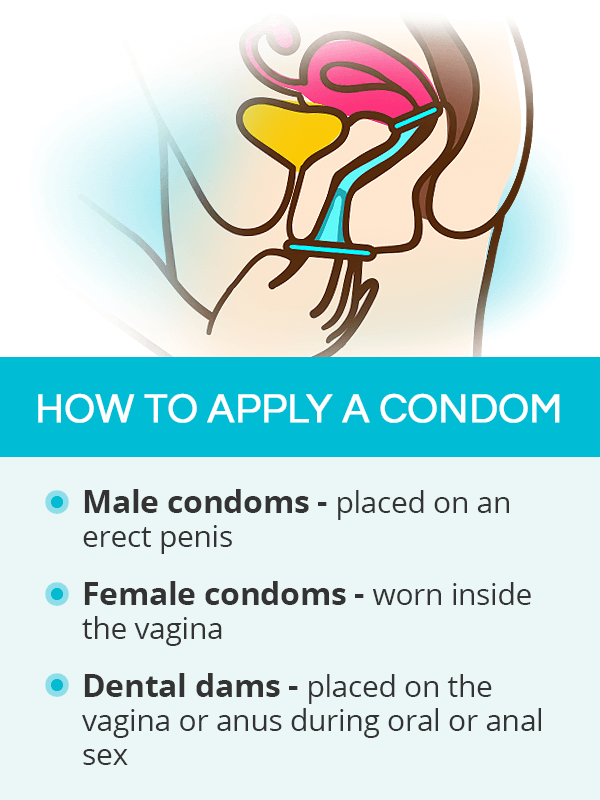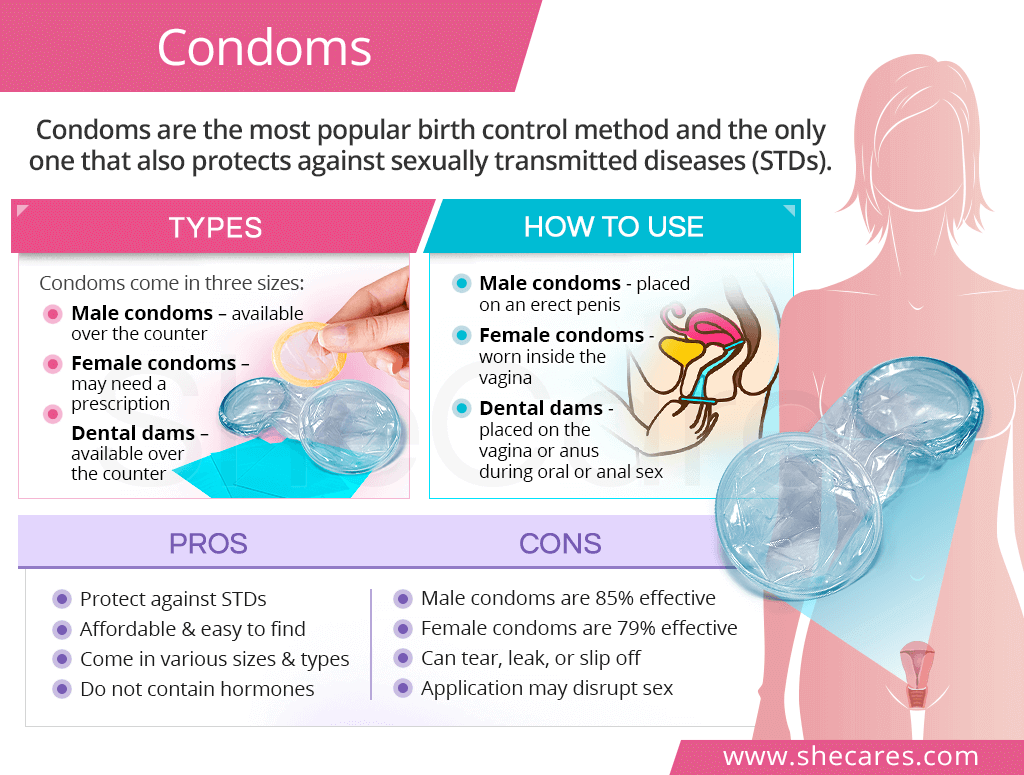About Condoms
Condoms are a barrier method of birth control. Most commercially available condoms are made with synthetic materials, such as latex, polyurethane, polyisoprene, or nitrile. Some may be made from natural fabrics, like lambskin.
Types of Condoms

There are three types of condoms, including the following:
Male condoms. Shaped as stretchy pouches, they are worn on the penis and are the most popular type of condoms.
Female condoms. Also called internal condoms, they are shaped as a loose pouch that is inserted in the vagina.
Dental dams. In the form of sheets, they are used to cover the genital area or anus during oral or anal sex.
Male condoms and dental dams are available over the counter at affordable prices. They also come in several sizes and may be lubricated with spermicide. Internal condoms, on the other hand, may only be available through prescription.
How Do Condoms Work
Being a barrier method of contraception, both male and female condoms prevent pregnancy by catching sperm and blocking their passage through the vagina up the reproductive tract.
In addition, all three types of condoms help lower the risk of contracting STDs by blocking contact with bodily fluids and genital skin. However, their effectiveness against STDs may depend on several factors, including condom's type and their use.
How to Use Condoms

Condoms may be used on their own or alongside other birth control methods to prevent STDs or as back-up contraception.
Male and female condoms can also be used with extra lubricant to reduce friction during sex. Keep in mind that oil-based lubricants may deteriorate latex or polyisoprene condoms. As such, water-based lubricants are recommended.
Male Condoms
As the name suggests, male condoms are worn by men. Upon being carefully taken out of the package, a condom is placed on an erect penis and gently rolled down its base. After sex, it should be carefully taken off the penis and thrown in the garbage. They should not be used more than once.
Female Condoms
Internal condoms have three parts: inner and outer rings and the pouch that connects both. To insert a condom, a woman should squeeze the inner (smaller) ring to elongate it and push it up her vagina like a tampon. The outer ring should stay outside the vagina to ensure its correct placement. After sex, it should be carefully pulled out and discarded.
Dental Dams
Dental dams are designed to create a barrier between intimate areas and the mouth to prevent STDs during oral and anal sex. Once a dental dam is removed from the package, it should be placed flat on skin so that it covers the vaginal opening or anus.
It is always crucial to check the expiration date on any type of condoms used. Proper storage is also key.
Pros and Cons of Condoms

Being easy to purchase and convenient to use, condoms are a go-to contraceptive method for many couples. However, they do come with a few disadvantages that are worth considering.
Pros of Condoms
- They are the only birth control method that can reduce the risk of contracting STDs.
- Since they include options made from non-latex materials, they are suitable for people with a latex allergy.
- Being hormone-free, they can be used by women who do not want to or cannot take hormonal contraception.
- They are affordable and easy to use, and most of them are available without prescription.
Cons of Condoms
- With typical use, male condoms are 85% effective, while female condoms have a 79% effectiveness.1,2
- They can leak, rip, and slip off, increasing the chances of accidental pregnancy or STDs.
- Some couples may feel that putting condoms on during sex interrupts their intimate moment.
Key Takeaways
With 450 million condoms sold each year in the United States alone, they are unlikely to fall out of use any time soon.3 Besides preventing pregnancy, condoms are the way to lower the risk of contracting STDs for sexually active people. They are available in three times: male condoms, which are worn on an erect penis; female condoms, which are inserted in the vagina; and dental dams, which are used to cover the vagina or anus during oral or anal sex. While they are favored for their convenience and ease of use, condoms' effectiveness is lower than that of other birth control methods, 85% for male condoms and 79% for female condoms. As such, many couples use condoms alongside other options to enjoy extra protection from unplanned pregnancies and STDs.
Sources
- American Pregnancy Association. (2013). Male Condoms. Retrieved October 12, 2020 from https://americanpregnancy.org/unplanned-pregnancy/birth-control-pills-patches-and-devices/male-condom-5015/
- CDC. (2016) Condom Effectiveness. Retrieved October 12, 2020 from https://www.cdc.gov/condomeffectiveness/index.html
- Cleveland Clinic. (2020). Condoms. Retrieved October 12, 2020 from https://my.clevelandclinic.org/health/drugs/9404-condoms
- Indian Journal of Sexually Transmitted Diseases and AIDS. (2015). Condoms: Past, present, and future. Retrieved October 12, 2020 from https://www.ncbi.nlm.nih.gov/pmc/articles/PMC4660551/
- NHS. (2020). Condoms. Retrieved October 12, 2020 from https://www.nhs.uk/conditions/contraception/male-condoms/
- Mayo Clinic. (2020). Male condoms. Retrieved October 12, 2020 from https://www.mayoclinic.org/tests-procedures/condoms/about/pac-20385063
- Medline Plus. (n.d.). Female condoms. Retrieved October 12, 2020 from https://medlineplus.gov/ency/article/004002.htm
- Planned Parenthood. (n.d.). Internal Condom. Retrieved October 12, 2020 from https://www.plannedparenthood.org/learn/birth-control/internal-condom
- Teens Health. (2018). Condoms. Retrieved October 12, 2020 from https://kidshealth.org/en/teens/contraception-condom.html
Footnotes:
- Mayo Clinic. (2020). Female condoms. Retrieved October 12, 2020 from https://www.mayoclinic.org/tests-procedures/female-condom/about/pac-20394129
- Planned Parenthood. (n.d.). Condom. Retrieved October 12, 2020 from https://www.plannedparenthood.org/learn/birth-control/condom
- 3Planned Parenthood. (n.d.). Fun Facts About Condoms. Retrieved October 12, 2020 from https://www.plannedparenthood.org/uploads/filer_public/54/38/5438b72e-82d6-4747-97bd-1a42c86d844c/fun_facts.pdf
